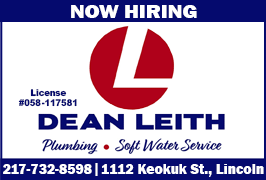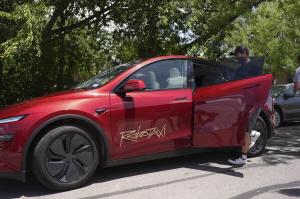Would you hail a 'robotaxi'? Musk bets cabs will give Tesla a lift after
boycotts and sales plunge
[June 23, 2025] By
BERNARD CONDON
NEW YORK (AP) — Elon Musk promised in 2019 that driverless Tesla
“robotaxis” would be on the road “next year,” but it didn’t happen. A
year later, he promised to deliver them the next year, but that didn’t
happen either.
Despite the empty pledges the promises kept coming. Last year in
January, Musk said, “Next year for sure, we’ll have over a million
robotaxis.”
Would you settle for 10 or 12?
Musk appears to be on the verge of making his robotaxi vision a reality
with a test run of a small squad of self-driving cabs in Austin, Texas,
that began Sunday. Reaching a million may take a year or more, however,
although the billionaire should be able to expand the service this year
if the Austin demo is a success.
The stakes couldn't be higher, nor the challenges.
While Musk was making those “next year” promises, rival Waymo was busy
deploying driverless taxis in Los Angeles, San Diego, Austin and other
cities by using a different technology that allowed it to get to market
faster. It just completed its 10 millionth paid ride.
Boycotts related to Musk's politics have tanked Tesla's sales. Rival
electric vehicle makers with newly competitive models have stolen market
share. And investors are on edge after a $150 billion stock wipeout when
Musk picked a social media fight with a U.S. president overseeing
federal car regulators who could make the robotaxi rollout much more
difficult. The stock has recovered somewhat after Musk said he regretted
some of his remarks.

Tesla shareholders have stood by Musk over the years because he’s defied
the odds by building a successful standalone electric vehicle company —
self-driving car promises aside — and making them a lot of money in the
process. A decade ago, Tesla shares traded for around $18. The shares
closed Friday at $322.
Musk seemed jubilant Sunday morning, posting on X, “The @Tesla_AI
robotaxi launch begins in Austin this afternoon with customers paying a
$4.20 flat fee!”
The test is beginning modestly enough. Tesla is remotely monitoring the
vehicles and putting a person in the passenger seat in case of trouble.
The number of Teslas deployed will also be small — just 10 or 12
vehicles — and will only pick up passengers in a limited, geofenced
area.
Musk has vowed that the service will quickly spread to other cities,
eventually reaching hundreds of thousands if not a million vehicles next
year.
Some Musk watchers on Wall Street are skeptical.
“How quickly can he expand the fleet?” asks Garrett Nelson, an analyst
at CFRA. “We're talking maybe a dozen vehicles initially. It's very
small."
Morningstar's Seth Goldstein says Musk is being classic Musk: Promising
too much, too quickly.
“When anyone in Austin can download the app and use a robotaxi, that
will be a success, but I don't think that will happen until 2028," he
says. “Testing is going to take a while.”
Musk's tendency to push up the stock high with a bit of hyperbole is
well known among investors.
In 2018, he told Tesla stockholders he had “funding secured” to buy all
their shares at a massive premium and take the company private. But he
not only lacked a written commitment from financiers, according to
federal stock regulators who fined him, he hadn't discussed the loan
amount or other details with them.
[to top of second column] |

A rider boards a driverless Tesla robotaxi, a ride-booking service,
Sunday, June 22, 2025, in Austin, Texas. (AP Photo/Eric Gay)
 More recently, Musk told CNBC in May
that Tesla was experiencing a “major rebound” in demand. A week
later an auto trade group in Europe announced sales had plunged by
half.
Musk has come under fire for allegedly exaggerating the ability of
the system used for its cars to drive themselves, starting with the
name. Full Self-Driving is a misnomer. The system still requires
drivers to keep their eyes on the road because they may need to
intervene and take control at any moment.
Federal highway safety regulators opened an investigation into FSD
last year after several accidents, and the Department of Justice has
conducted its own probe, though the status of that is not known.
Tesla has also faced lawsuits over the feature, some resulting in
settlements, other dismissed. In one case, a judge ruled against the
plaintiffs but only because they hadn't proved Musk “knowingly” made
false statements.
Musk says the robotaxis will be running on an improved version of
Full Self-Driving and the cabs will be safe.
He also says the service will be able to expand rapidly around the
country. His secret weapon: Millions of Tesla owners now on the
roads. He says an over-the-air software update will soon allow them
to turn their cars into driverless cabs and start a side business
while stuck at the office for eight hours or on vacation for a week.
“Instead of having your car sit in the parking lot, your car could
be earning money,” Musk said earlier this year, calling it an Airbnb
model for cars. “You will be able to add or subtract your car to the
fleet.”
Musk says Tesla also can move fast to deploy taxis now because of
his decision to rely only on cameras for the cars to navigate,
unlike Waymo, which has gone a more expensive route by supplementing
its cameras with lasers and radar.
“Tesla will have, I don’t know,” Musk mused in an conference call
with investors, ”99% market share or something ridiculous.” Given
Waymo's head start and potential competition from Amazon and others,
dominating the driverless market to that extent could be a reach.
But Dan Ives, a Wedbush Securities analyst and big Musk fan, says
this time Musk may actually pull it off because of Tesla's ability
to scale up quickly. And even skeptics like Morningstar's Goldstein
acknowledge that Musk occasionally does gets things right, and
spectacularly so.

He upended the car industry by getting people to buy expensive
electric vehicles, brought his Starlink satellite internet service
to rural areas and, more recently, performed a gee-whiz trick of
landing an unmanned SpaceX rocket on a platform back on earth.
“Maybe his timelines aren’t realistic," Goldstein says, “but he can
develop futuristic technology products.”
All contents © copyright 2025 Associated Press. All rights reserved |